Mars Desert Research Station End of Mission Summary
Crew 193 – Gold Crew
Gold Crew
| Commander: | Anima Patil-Sabale (second from left) |
| Executive Officer: | Doug Campbell (left) |
| Crew Engineer: | David Attig (center) |
| Health and Safety Officer: | Shawna Pandya (second from right) |
| Crew Geologist and Astronomer: | Eric Shear (right) |
Facebook: https://www.facebook.com/phenommdrsgold193
The Gold Crew is composed of a team of Project PHEnOM Citizen Scientist-Astronaut Candidates from the US and Canada. Along with a great passion for space exploration, every member in the crew has a varied skillset in addition to expertise in their specific field.
The crew came in with great enthusiasm on this mission, successfully completed several research projects, enjoyed exploring Mars while working hard every single day and leaves with satisfaction about successfully completing their mission and research as planned. There was never a dull moment on Mars when the Gold crew was around, even when bad weather forced the crew to stay indoors, the crew had a busy day working on MDRS projects, hab maintenance and cooking a feast!
The crew stayed fit and in good physiological and psychological health during the mission except for a few minor incidents. They experienced how crew dynamics change when a group of accomplished individuals from different backgrounds come together. Debriefing meetings helped the crew discuss concerns openly and helped each member understand strengths and weaknesses and work on those, which in turn helped the crew bond better.
This crew definitely knows how to work hard and play hard. Every night had a team building activity that included learning the American Sign Language from our deaf crew member, playing cards and games or watching movies together. From singing to plants in the greenhab, to making them mandatory Tang-ful Martian sols, to successful baking and cooking experiments in the kitchen, the ‘work hard while you play hard’ quotient of the crew was always obvious.
The crew graciously opened up a sol from their schedule to welcome a group of middle school students, gave them a tour of the MDRS facilities and addressed their curiosities. They compiled outreach videos and have been addressing questions they have been receiving during the mission on social media.
The crew’s rotation at MDRS has aroused interest about living on Mars amongst their followers. They plan to continue their research and advocate Mars colonization and space exploration after getting back to Earth. With this successful mission behind them, they look forward to destination Mars and doing everything possible on their part to help mankind get there.
THE SCIENCE DOME
Summary of Operations
For our two-week mission to continue the colonization of mars, we have several science and research objectives to accomplish. The results are summarized below.
1. Waterless dish cleaning: A waterless dishwasher prototype was developed on this mission. Multiple tests were conducted to see the bacterial growth on plates that were dirty, plates that were washed in the conventional way and plates that were sanitized using UV light. Initial results show promise in the waterless dishwasher. Samples will be more fully analyzed once we return to earth.
2. Emergency EVAC EVA: Several evacuation locations were identified in the area surrounding our campus. These areas are able to provide a crew with shelter from wind, radiation, and shelter an incapacitated crew member (see pictures).
3. Sunspot and Solar Flare Monitoring: Crew astronomer was able to find several different features of the sun during our rotation. He found sunspots, prominences and flares which are further detailed in a different section of this report.
4. Shortwave Texting on EVA’s: The beartooth devices were a large letdown on this mission. They only functioned properly for one EVA and then would not connect again. Hand signals and writing were used instead to connect with our deaf crew mate.
5. GPS Route Measurements: Route mapping of several EVAs occurred and will be analyzed by a remote PHEnOM crew member once we return to earth. He will be looking at the routes we took to traverse the terrain in relation to the easiest way to travel.
6. Spacesuit Helmet Fogging: The crew was diligent about using de-fogging spray on their visors prior to each EVA. As such, the crew reported no fogging during any of their EVAs. Recommend this process be used for future crews.
7. Crew Comfort, Health and Safety on EVA: Many important lessons were learned about optimizing crew, health, safety and comfort. Results will be written up by this crew and shared for the Mars Society for use with future crews. Main takeaway was the importance of staying hydrated and immediately returning to base if any crew member felt off nominal.
THE GREENHAB
Summary of Operations
GreenHab operations were relatively uneventful during Crew 193’s 2-week stay at the Mars Desert Research Station. The crew had initially started on a once-a-day watering schedule, but between the collective experiences of the group, the site Director’s observation that the plants seemed underwatered, and a little Googling, soon moved to a twice-a-day watering schedule, averaging 8-10 gallons a day. MiracleGro was added approximate three times throughout the rotation. Other usual Hab operations, including fan usage (minimal), shade covering (always on), and door closure (usually open for a few hours in the afternoon) did not seem to differ greatly versus other rotations. Temperatures seemed to range between an average low of 15oC, and average high of 49-51oC and a mid-range in the 30s.
Yield
Overall, with some pep talks, singing and a little TLC, the plants recovered nicely and yielded a variety of crops throughout the rotation, including:
|
 |
THE OBSERVATORY
Summary of Operations
Each day, the crew astronomer ventured out to the Musk Observatory to open the dome, rotate it to the sun if necessary, uncover the telescope, turn it on, and steer it towards the sun. Once the telescope was aligned to the sun, the eyepiece was taken out of the solar astronomy box and inserted into the block so the astronomer could get a clear view of the sun after turning the focus knobs. After attempting to identify solar features through the eyepiece, the astronomer replaced it with a Skyris camera connected to the laptop computer. The camera often exposed features that could not be seen with the eyepiece, but it had a narrower field of view so its use came after the eyepiece. For each area of interest, several hundred images were taken over 35 seconds and stacked together in Autostakkert. The resulting composite image was processed in Registax to bring out wavelets, and further sharpened in Photoshop. The final image was colorized a lovely shade of yellow in PowerPoint.
Recommendations for Future Crews
Atmospheric turbulence was noticeably lower in the mornings than in the afternoons, due to the atmosphere not yet heating up from the night. Observations should be made in the mornings as often as possible for best results. It also pays to use the tuners on the telescope – they can make certain solar features apparent while “muddying” out others. Beware of turning them too far, or imperfections will become visible in the lens itself!
ENGINEERING
The crew engineer has many tasks to do each day, along with maintaining the tools and work station downstairs in the HAB. The generator was turned on every night, and off every morning, and water pumped into the loft tank whenever it gets low (about twice per day, depending on water usage). This crew averaged approximately 65 gallons per day. While this may be a lot for a crew of 5, it is low enough that we did not run out of water. As the static tank (just outside the HAB) was depleted, water was moved from a secondary tank to replenish it.
While working on these (and doing EVAs), it is up to the engineer to keep the EVA suits in order, and make general repairs around the HAB. Keeping up with these, and the solar control panel’s finicky nature is a full-time job.
During this rotation, repairs were made to two suit chargers, and one EVA suit (#10). One more suit (number 9) failed during the last EVA and will not be repaired on this rotation. The nature of the failure is the fan blades impacted the plywood frame that the fans were mounted to. The operator reported smelling burnt plastic, indicating that the fan motors were overloaded to the point of failing; the fans will need to be replaced with new ones. I suggest a larger hole, to prevent the fan blades from interfering with the plywood; a precursor to this failure had been noted before, as a “grinding” noise could be heard when bending down or standing up in that suit; indicating that the blades did make occasional contact with the wood around it.
The two-piece suits are still not all operational; the black straps connecting the neck ring to the helmet needs to be replaced (or extremely tightened) on three suits, and one more of the suits has a broken charging connector (the release button is missing; as I only got the soldering iron a couple days ago, I have not repaired this yet).
Radios were also rotated during this rotation. Some older style radios whose batteries discharge very quickly (and these radios do funny things as their batteries die) were removed from service. There is a set of radios slated to be moved to the solar observatory, and all other radios in the HAB are now the newer style. There are three more sets on the shelf for future crews to cycle through as the current radios wear out. Some tools were moved out to the RAM for use as well.
After wearing a two-piece EVA suit on multiple occasions, the crew came to the conclusion that the two-piece EVA suits are somewhat more dangerous to wear than the one-piece suits. This can be remedied by tying the neck-ring to the shoulder straps, in order to stop the helmet from sliding around as the operator moves. This is particularly dangerous if the operator falls while on EVA, as the ring/helmet may contribute to a neck injury.
Recommendations for Future Crews
It is strongly recommended that future crews bring safety glasses, as none could be found in the HAB. While the HAB lower level is organized, the toolbox is not very well organized, and a future crew could help by attempting to level the wheels of it (to allow the drawers to open/close more smoothly).
Before a rotation starts, the future crew should also organize the tools in the RAM toolbox and add more when necessary. It is also advisable to not work in the RAM during the hottest time of day, without a fan on.









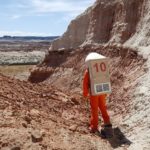
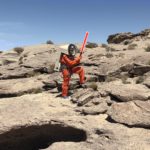

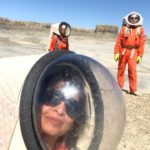
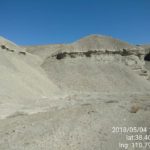
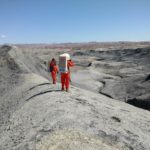
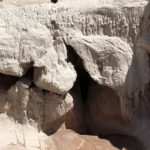
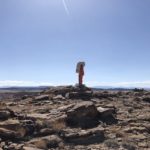
You must be logged in to post a comment.